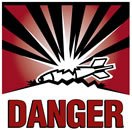
|
|
TOPICS |
|
What's New |
|
|

The Unexploded Explosive Ordnance (UXO) Hazard At Grey Goose Island
Location
Grey Goose Island is located 65 kilometres northwest of Chisasibi, Quebec, in the northeastern sector of James Bay, Canada. Grey Goose Island is part of Nunavut.
Topography, Vegetation and Wildlife Harvesting
Grey Goose Island is predominately low-lying and flat with a mixture of rock and sand dominating the landscape. With no trees on the island, sparse grasses and other hardy plants form the basis of vegetation.
The island is frequented by seals, caribou, polar bears and several species of migratory birds. The Cree First Nation uses the island on an infrequent basis for harvesting of these wildlife resources.

US Air Force RB-52C Stratofortress Bomber

150-lb M120 photoflash bomb
History
At the height of the Cold War, Canada granted the United States use of a section of James Bay for the purpose of bombing and gunnery training. From 1958 to 1965, Grey Goose Island, which is at the center of this section of James Bay, was used as the target for high altitude photo reconnassaince practice using the RB-52C Stratofortress.
150-lb M120 photoflash bombs, dropped from high altitude, were set to explode at medium altitude. These bombs produced a very bright light for a fraction of a second, which allowed for photography of ground based targets. In addition, the bombers may have dropped practice bombs and fired small caliber machine gun rounds in the area.
In 1965, the range ceased to be used. In the interests of public safety, it has since been retained by Canada’s Department of National Defence (DND) because of the possibility that unexploded explosive ordnance (UXO) such as photoflash bombs and other munitions may still remain in the area.
Types of Ammunition Used
Bombs: 150-lb M120 photoflash bombs. If these heavy bombs failed to explode in the air as intended, they may have penetrated the surface of the island or the surrounding seabed to a substantial depth;
Practice Bombs: 11½ or 16½-lb practice bombs containing a cartridge composed of smokeless powder (phosphorous composition). These charges can cause serious burns and loss of eyesight;
Other Ammunition: 20mm and .50 calibre anti-aircraft rounds. This ammunition was fired by aircraft during air-to-air combat practice.
The Risk
The risk to the public is considered to be significant: low in frequency, but high in potential severity. The risks associated with unexploded photoflash bombs are serious burns and blindness due to photoflash powder. Unexploded photoflash bombs pose a considerable risk to public safety.
Approaches to Mitigation
- DND is conducting a community visit to nearby Chisasibi in order to gather anecdotal information from elders and perform a site reconnaissance of Grey Goose Island;
- A community meeting is planned for the summer of 2006 to increase public awareness of UXO; and
- Once historical research is completed, a decision will be made regarding the need for future site investigation work using geophysical survey technology.
| Publication Date: 2006 06 30 | Important Notices |

